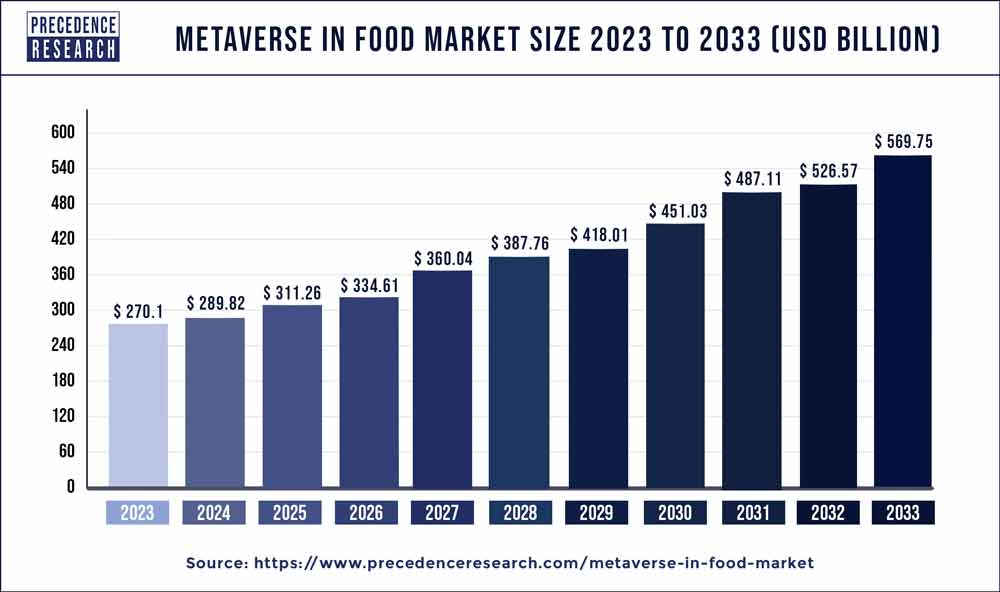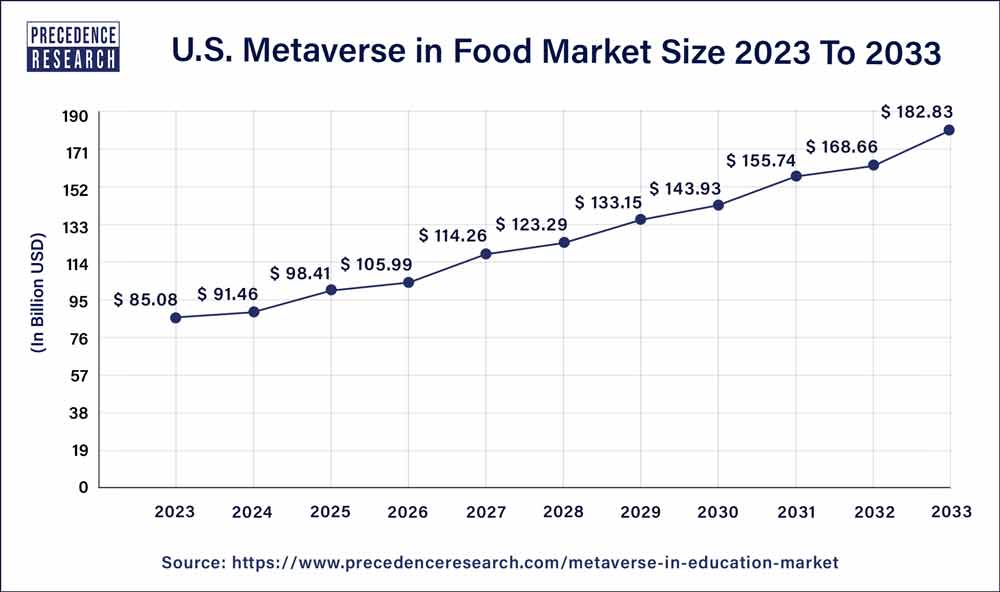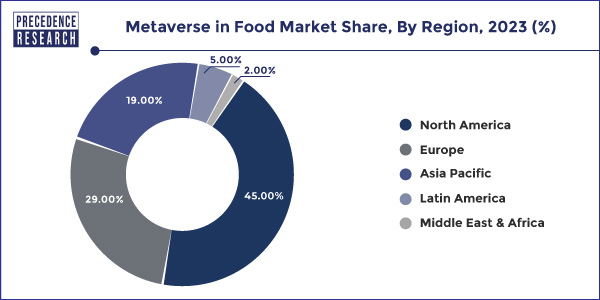February 2024
Metaverse in Food Market (By Consumer: Tech-savvy Early Adopters, Experience-driven Foodies, Health-conscious Consumers, Sustainability-focused Consumers; By Food Type: Luxury and Gourmet Foods, Personalized Dietary Needs, Exotic and Culturally Diverse Cuisines, Experimental and Virtual-only Creations) - Global Industry Analysis, Size, Share, Growth, Trends, Regional Outlook, and Forecast 2024-2033
The global metaverse in food market size was valued at USD 270.1 billion in 2023 and is anticipated to reach around USD 569.75 billion by 2033, poised to grow at a CAGR of 7.80% from 2024 to 2033.

The U.S. metaverse in food market size was estimated at USD 85.08 billion in 2023 and is expected to surpass around USD 182.83 billion by 2033, growing at a CAGR of 8% from 2024 to 2033.

In 2023, North America holds a share of 45% in the metaverse in food market due to its robust technological infrastructure, widespread digital adoption, and a high level of consumer engagement. The region's well-established tech industry facilitates the seamless integration of virtual experiences, while a tech-savvy population embraces innovative digital platforms. Additionally, a strong food culture and a thriving market for culinary exploration contribute to the significant share. The convergence of advanced technology, cultural openness, and a digitally engaged populace positions North America as a key leader in shaping the metaverse in the food market.

The metaverse in the food market is poised for rapid expansion in Asia-Pacific due to a convergence of factors. The region's tech-savvy population, increasing internet penetration, and growing appetite for digital experiences contribute to the market's potential. Additionally, a vibrant food culture and a rising middle class amplify the appeal of virtual dining and culinary exploration. As businesses and consumers embrace digital innovation, the Asia-Pacific metaverse in the food market stands at the forefront of a transformative shift, promising significant growth and widespread adoption.
Meanwhile, Europe is witnessing significant growth in the metaverse in the food market due to a confluence of factors. Increased technological infrastructure, rising digital literacy, and a tech-savvy population contribute to the region's embrace of virtual experiences. The diverse culinary culture in Europe aligns well with the creative opportunities offered by the metaverse, attracting both businesses and consumers. Additionally, supportive government initiatives and a robust online ecosystem foster innovation, propelling the metaverse in the food market to thrive and gain prominence across the European continent.
Metaverse in Food Market Overview
The metaverse in the food industry refers to a digital realm where virtual and augmented reality technologies converge to create immersive culinary experiences. In this virtual space, users can engage in a variety of food-related activities, from exploring virtual restaurants and attending digital food festivals to participating in cooking classes with virtual chefs. It opens up opportunities for virtual dining, online culinary education, and gamified food experiences. Additionally, brands can establish a metaverse presence for marketing and engagement, while supply chains and nutritional education can be visualized in innovative ways. The metaverse in food embodies a fusion of technology and gastronomy, offering users novel and interactive ways to explore, experience, and engage with the culinary world beyond physical boundaries.
Metaverse in Food Market Data and Statistics
| Report Coverage | Details |
| Growth Rate from 2024 to 2033 | CAGR of 7.80% |
| Global Market Size in 2023 | USD 270.1 Billion |
| Global Market Size by 2033 | USD 569.75 Billion |
| U.S. Market Size in 2023 | USD 85.08 Billion |
| U.S. Market Size by 2033 | USD 182.83 Billion |
| Base Year | 2023 |
| Forecast Period | 2024 to 2033 |
| Segments Covered | By Consumer and By Food Type |
| Regions Covered | North America, Europe, Asia-Pacific, Latin America, and Middle East & Africa |
Driver: Brand partnerships and marketing success
The growing collaboration between brands and successful marketing strategies is significantly boosting the demand for the metaverse in the food market. As brands increasingly recognize the potential of the metaverse, partnerships are formed to create immersive experiences for consumers. Marketing success in this virtual space has become a catalyst for market growth, as it captivates audiences and enhances brand engagement. This surge in demand is not only driven by technological advancements but also by the effective synergy between brands and metaverse platforms.
Furthermore, the metaverse in the food industry is gaining traction as marketing efforts focus on creating interactive and memorable experiences. Brands leverage the virtual world to showcase products, offer unique promotions, and build a strong online presence. The combination of brand partnerships and successful marketing endeavors is propelling the Metaverse in the food market, shaping it into a dynamic and thriving space for both businesses and consumers.
Restraint: Technological barriers
The growth of the metaverse in the food market encounters challenges primarily rooted in technological barriers, impeding widespread adoption. Many smaller food businesses face hurdles in integrating the metaverse due to a lack of access to advanced technologies and expertise. The demanding nature of metaverse implementation requires businesses to invest in cutting-edge tools, which can strain resources and limit the participation of smaller players in the market.
Moreover, the complexity of incorporating the metaverse into existing food systems poses a learning curve for businesses. Training staff and adapting to new technologies may be resource-intensive, further hindering seamless integration. Consequently, these technological barriers act as restraints on the market demand for the metaverse in the food industry, emphasizing the need for accessible solutions and supportive frameworks to ensure broader participation and successful implementation.
Opportunity: Personalized food experiences
The arrival of personalized food experiences within the metaverse is a game-changer, creating remarkable opportunities in the food market. By leveraging advanced technologies, businesses can tailor virtual culinary adventures to individual preferences. Virtual menus and interactive platforms allow users to customize their food experiences, from choosing ingredients to exploring unique flavor combinations, enhancing customer engagement and satisfaction.
Furthermore, the ability to cater to specific dietary needs and preferences within the metaverse offers a level of personalization that transcends traditional dining experiences. Businesses can seize this opportunity to not only meet individualized consumer demands but also to gather valuable data on user preferences, enabling targeted marketing strategies. The integration of personalized food experiences in the metaverse is reshaping the market landscape, presenting a compelling avenue for food businesses to connect with consumers on a more intimate and customized level.
The experience-driven foodies segment held the highest market share of 33% in 2023. In the metaverse in food market, the experience-driven foodies segment refers to consumers seeking immersive and engaging culinary adventures. These individuals prioritize interactive virtual dining experiences, personalized menus, and unique flavor explorations. The trend involves a growing demand for virtual tastings, interactive cooking classes, and dynamic collaborations with chefs and brands. As technology advances, the metaverse caters to the preferences of experience-driven foodies, offering a novel platform for customized and enjoyable food encounters, redefining how consumers engage with and savor their culinary experiences.
The tech-savvy early adopters segment is anticipated to witness rapid growth at a significant CAGR of 8.12% during the projected period. Tech-savvy early adopters in the metaverse in food market represent consumers who eagerly embrace new technologies. This segment seeks immersive culinary experiences, navigating virtual platforms to discover and engage with innovative food offerings. Trends indicate a preference for personalized virtual menus, interactive cooking simulations, and social dining experiences. As pioneers in metaverse interactions, these consumers influence the market by fostering demand for cutting-edge virtual food events and collaborations, shaping the future landscape of digital gastronomy.
The exotic and culturally diverse cuisines segment has held a 35% market share in 2023. In the metaverse in food market, the segment defined by exotic and culturally diverse cuisines is gaining significant attention. This category encompasses virtual spaces dedicated to exploring and experiencing unique global flavors. Users can engage in immersive culinary journeys, sampling dishes from various cultures within the digital realm. This trend reflects a growing demand for diverse and exotic food encounters, allowing users to virtually travel the world through their taste buds, fostering cultural appreciation and expanding the possibilities of gastronomic exploration in the metaverse.
The personalized dietary needs segment is anticipated to grow rapidly over the projected period. In the metaverse in the food market, the personalized dietary needs segment caters to individual nutritional preferences. This innovative approach allows users to tailor virtual dining experiences based on specific dietary requirements such as vegetarian, vegan, gluten-free, or other health considerations. Recent trends show a surge in demand for personalized dietary options within the metaverse, reflecting a growing awareness and prioritization of individualized nutrition. This segment not only enhances user satisfaction but also aligns with the broader trend of health-conscious consumer choices in the digital dining landscape.
Segments Covered in the Report
By Consumer
By Food Type
By Geography
For questions or customization requests, please reach out to us at sales@precedenceresearch.com
No cookie-cutter, only authentic analysis – take the 1st step to become a Precedence Research client
February 2024
January 2024
January 2024
January 2025